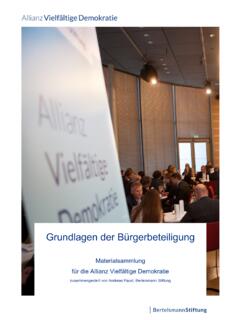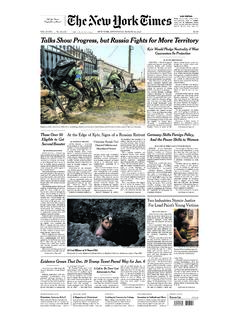Transcription of Migration and Globalization Forms, Patterns and Effects
1 Page 102 | Trilogue Salzburg 2017 Background Paper Migration and Globalization Forms, Patterns and Effects Thanos Dokos Introduction Starting with the slow outward movement of our common African ancestors, Migration is as old as humanity itself and played an important role in the evolution of culture and civilization. Without migrants spreading their various cultures, languages, religions, customs, ideas and ways of life, the course of world history most certainly would have evolved quite differently. As the global population increased from billion in 1970 to billion today, Globalization , economic inequalities and demographic developments have contributed to sizeable migratory flows, predominantly from the Global South to the Global North. Europe is faced today with a conflict zone stretching across the Middle East and North Africa, and with several fragile countries, rapidly growing populations, rising urbanization and huge economic inequalities in sub-Saharan Africa and South Asia.
2 Europe is currently faced with daunting challenges: monitoring and protecting its borders, managing Migration flows, attracting skilled labor to address its economic needs, managing tension with migrant communities (especially Muslim ones) to protect social cohesion and stability and integrating those communities to the greatest extent possible. There appears to be a divergence between the economic rationale, on the one hand, and the social cohesion and internal security rationales, on the other, in the context of a European Migration policy. In principle, demand for labor might encourage a more liberal attitude toward economic migrants from the Global South, and/or the development of new guest-worker arrangements with North African and other states in Europe s extended southern neighborhood , on a national or European level. As a result of current trends, European economies may benefit while social cohesion and internal stability may deteriorate.
3 Migration pressures are expected to become more acute in the future. This evolving refugee/ Migration crisis, if not successfully managed, may become an existential threat for an EU already weakened by euroskepticism, the financial crisis and Brexit. There seems to be a new division inside the Union, between a German-led group supporting a European solution to the refugee problem and the Visegrad group and like-minded countries, as well as far-right political parties across Europe, arguing in favor of fences and a Europe-fortress mentality. Using a scenario-based approach, this paper will briefly explore the relationship between Globalization and Migration , and the impact of Globalization and other main trends and drivers on population movements. Then it will make an effort to answer two key questions: (1) What are the emerging or new Patterns of Migration ? (2) What do future scenarios of Migration look like and what do they imply?
4 In this context, a number of more specific issues will be addressed, including the impact of Globalization on Migration , brain-drain phenomena and integration policies. The paper will conclude with a summary of main findings and a short list of policy recommendations as to how decision makers in the EU could incorporate best practices and ideas into policy-making and how the Union should pursue or deal with the Effects of Globalization and Migration to respond to current and emerging challenges. Background Paper Trilogue Salzburg 2017 | Page 103 Global and European Trends and Drivers1 Affecting Migration The pace and direction (in order to cover not only the core but also the gap ) of Globalization is only one of several trends and drivers influencing population movements, albeit an important one. Others include (a) global and regional demographic trends (especially regional population increase/decrease and the pace of urbanization); (b) the state of the global economy (will the rise of the rest continue?)
5 If yes, this may significantly affect South-South Migration ); (c) the number and intensity of regional, interstate and intrastate conflicts; and (d) the impact of climate change. It is also argued that the Migration weapon has been used by transit states (like Iran or Turkey) and non-western great powers (like Russia) to instrumentalize the flows for political reasons. If this is indeed the case, similar actions may be repeated in the future. In addition to the above push factors, there are pull factors at play, such as the policies of receiving countries (with emphasis on European ones, for the purposes of this paper). Relevant factors will be both quantitative (total size of flows to Europe, as well as numbers per receiving country) and qualitative (skills, country of origin and other characteristics of migrants). Other relevant factors will be the state of the EU (integration vs.
6 Disintegration, economic and demographic factors, the rise of populism and the salience of security issues [terrorism + radicalization], as well as Migration and integration policies at the European and national level. 1 NATO defines a trend as the evolution of repetitive events. Consequently, trends show how the components (domains) are changing. (FSE 2025, p. 11) According to the DCDC, a trend is a discernible pattern of change (Global Strategic Trends Out to 2040, p. 6). According to the DCDC, a driver is a factor that directly influences or causes change (Global Strategic Trends Out to 2040, Strategic Trends Programme, UK Ministry of Defence, 4th edition, January 2010, p. 6). For NATO, a driver designates the course of an event that results in a specific trend into a component (Future Security Environment (FSE) 2025, Supreme Allied Commander, Transformation, Norfolk, Virginia, June 2007, p.)
7 11). Jair van der Lijn defines drivers as underlying causes or incentives for an actor or phenomenon (Jair van der Lijn, Crystal Balling Future Threats 2020 2030: Security Foresights of Actors and Drivers in Perspective, Defense & Security Analysis, Vol. 27, No. 2, June 2011, p. 149). Page 104 | Trilogue Salzburg 2017 Background Paper 1. Globalization and Migration Globalization is truly the megatrend of our times and its impact is being increasingly although unequally felt in almost every region of the world. Anthony Gidens defined Globalization as the intensification of worldwide social relations which link distant localities in such a way that local happenings are shaped by events occurring many miles away and vice versa. Globalization , interchangeably treated as a process, a condition, a system, a force and an age, can also be described as the expansion and intensification of social relations and consciousness across world time and world space.
8 Most experts would agree that Globalization as a process has been ongoing for more than 500 years, as it is linked to the 16th century emergence of capitalism in Europe and the subsequent expansion of the capitalist world-system around the globe. It should be noted that the process has reached its peak during the past 25 years (facilitated by the end of the Cold War). For several years now, distant events have been having a deeper impact on our lives. The boundaries between domestic matters and global affairs have become increasingly blurred and local developments may come to have enormous global consequences. The term Globalization is often being used to describe this interconnectedness between the global and local levels. Although few would dispute the fact that Globalization has led to a substantial reduction of global disparities in wealth and well-being between the Global North and the Global South, there is also little doubt that sizeable groups inside countries have not benefited from Globalization ( the losers of Globalization ).
9 Furthermore, there is a clear connection between Globalization and population movements, especially migratory ones. The two spheres unavoidably overlap and are interconnected. Globalization causes Migration and Migration contributes to the intensification of socioeconomic and political relations across borders. Globalization has indeed dislocated millions of people and set in motion population movements that are now hard for anyone to control. This represents a Background Paper Trilogue Salzburg 2017 | Page 105 serious political challenge to nation- states , which often can no longer effectively regulate who crosses their borders, either because they are unable to enforce immigration laws or lack the resolve to do so, raising the critical question of whether national boundaries are on the way to obsolescence. A certain level of uncertainty exists around the extent to which Globalization and technological change will continue to have an impact on future Migration trends.
10 Technology and economic development make it increasingly easy for migrants to travel inexpensively, to learn about available routes and to stay in touch with family and community members abroad, but the level of use and absorption is difficult to measure. Continuing Globalization is likely to support Migration trends as well, as the expansion of media, languages and businesses facilitates interactions across borders. Telecommuting and outsourcing, however, may act as a restraint on Migration . Brexit, the Trump election and strong anti- Globalization voices in various European countries have led to speculation that the Globalization era may be coming to a sudden end or that, at a minimum, Globalization s tempo is decelerating and its role declining. Our working assumption is that Globalization may, perhaps, slow-down as a global trend or be temporarily and partially reversed in some regions of the world, but a return to the pre- Globalization era is highly unlikely unless, of course, a game changer ( black swan ) of global dimensions takes place.











